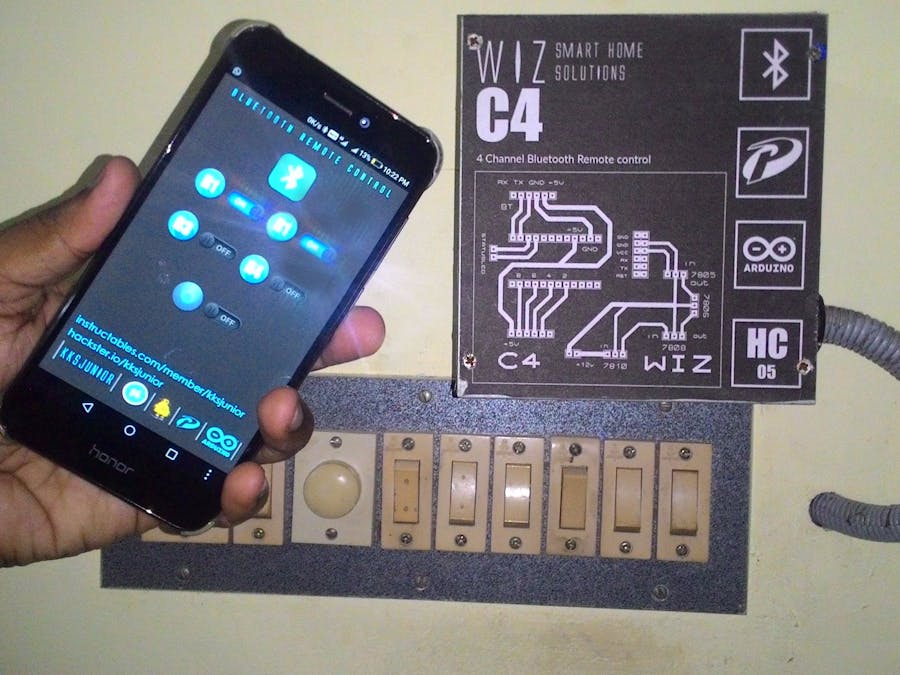Hello, all.
This project is all about building the most simplified home automation device using an Arduino and a Bluetooth module. This one is very easy to build and it can be built in a few hours. In my version which I'm explaining right here, I can control up to 4 home appliances using my Android smartphone.
Let's have a look at the list of materials and tools you'll need.
- Arduino Pro Mini (Link to the store)
- HC-05 Bluetooth module (Link to the store)
- 5V 4 Channel Relay Module (Link to the store)
- 5V Power Supply
- Male and Female headers
- Perfboard (I recommend making a PCB, but if you want to do it the easy way a perfboard is better)
- Soldering kit
- Glue gun
- Android smartphone
- Screwdrivers
- Wire strippers, etc.
That's all we need.
The CodeThe code is attached in the end of this project.
Download the Arduino IDE from here.
This code uses softwareserial.h to configure rx and tx pins in the Arduino. These rx and tx pins are connected to the tx and rx pins of the HC-05 Bluetooth module respectively.
The Bluetooth module receives data from a paired Android device and triggers the relays with respect to the data received.
For example, in my code if the received data is the character "A", the relay 1 will be triggered ON and if the received data is the character "B", the relay 1 will be turned OFF.
Similarly all the relays can be turned ON/OFF using Bluetooth commands. Refer the code for detailed comments.
EEPROMEEPROM is the acronym for Electronically Erasable Programmable Read Only Memory, which is used here to store the status of the relay (ON/OFF), so that in case of a power failure when the controller resets, all the relays which were kept ON will come back to their ON position after the power has come up. So whenever a relay is turned on, a variable stored in an address in the EEPROM changes it's value to 1 and whenever it's turned OFF the same variable changes to 0. Each relay has it's own variable assigned to store it's status in the EEPROM. So at the beginning of the code the first thing we did was to initialize the relays according to the values stored in the EEPROM.
If you're using an Arduino Pro mini you'll need a USB to TTL converter to dump the code in to the Arduino.
The Android ApplicationAs I said in the above step, the micro-controller triggers each relay according to the data it receives through the Bluetooth Module from an Android device. So we require an Android application to send these data to the HC-05.
I made my own customized application using the MIT App inventor. I've attached the 'blocks layout' of my application as a PDF here for reference for those who are going to make their own app using the App Inventor.
If you don't want to bother making the app, you can just download the ready to use App (Compatible with the code I've uploaded here) attached in the end of this project.
Instructions for the Android AppYou need pair the HC-05 Bluetooth module to your Android device before you could use it in the app.
Step 1: Open your device's Bluetooth settings and search for new devices, make sure the LED on HC-05 module is blinking continuously (Pairing Mode).
Step 2: Select HC-05 (or you'll see an address ending with "C" as shown in the pictures).
Step 3: Enter the PIN "1234" and press OK.
Step 4: Open the "Wiz Smart Home" app and click the Bluetooth button on the top of the screen.
Step 5: Select "HC-05" from the list.
Step 6: Use the respective switches to turn ON/OFF the relays 1,2,3,4.
Step 7: Click the Master to turn all the relays ON/OFF in a single click.
The Circuit- Pin 11 of Arduino to TX Pin of HC-05 Module.
- Pin 10 of Arduino to RX Pin of HC-05 Module.
- GND of HC-05 to GND in Arduino.
- Vcc of HC-05 to Vcc (5v) in Arduino.
- Vcc of Relay Module to Vcc (5v) in Arduino.
- GND of Relay Module to GND in Arduino.
- Pin 2 of Arduino to R1 of Relay Module.
- Pin 4 of Arduino to R2 of Relay Module.
- Pin 6 of Arduino to R3 of Relay Module.
- Pin 8 of Arduino to R4 of Relay Module.
- Give 5-v power supply to the power pins of Arduino.
- Pin 12 and 13 are the Pins for the Power indication and the Bluetooth Status Indication LEDs respectively
That's it for the device.
In-order to control the mains, connect the "Normally Open" contacts of the each relay across the respective switches of the home appliances you'd wish to control or loop the live wire through one contact of "NO" of all the relays and connect the leads to the appliances to the other contact of "NO" of their respective relays.
PCB DesignThis is a very simple circuit. You can solder it on a perfboard in no time, but if you still wish to make a PCB, I'm attaching the PCB Design which I've made using Proteus 8 Pro. My version also had a series of voltage regulators which I've shown in the pictures.
Assembling the ComponentsI used the enclosure of an old computer SMPS to make the case for my device. It'll be better to design a custom case according to your needs using Fusion 360 or any other 3D design software and 3D print the design to give your project a super-cool look. I printed some labels and pasted it on the SMPS enclosure to fill the empty look of it. I drilled some holes in it and fixed it on the wall next to the switch board. The wires were hidden using a small plastic pipe leading in to the switchboard.
Thank You!
















_3u05Tpwasz.png?auto=compress%2Cformat&w=40&h=40&fit=fillmax&bg=fff&dpr=2)
Comments
Please log in or sign up to comment.